

Pinterest Bookable Pin is an implementation of a booking feature on Pinterest, which allows consumers who seek for an immersive traveling experience to directly book beds through the Pinterest platform. It is a UX focused project which the team and I had devloped during the last project of IAT 438 Interactive Objects and Environments, where students are responsible in finding their own client and create a digital solution in improving its business.
How might we improve the public perception on hostels while establishing Generator as the premium hostel brand across the globe?
As the UX Strategy of the team. I emphasized on providing users the most desirable experience. By utilizing both cognitive and emotional empathy to understand users’ needs, I formed guidelines and made the general plan for our UI and visual design leads in designing our final product. I also played a major role in UX research, as well as content management. Lastly, I redesigned the user interface and protytype.
Anya Valueva, Derek Tam, Jimmy Hsu, Zhanna Krupinina, Tavan Sohi
Adobe Illustrator, Adobe Photoshop, Sketch, Flinto, Keynote
Case Study
4 weeks (Fall 2016)
Generator Hostel is a European based hostel chain that creates high-end experience by incorporating local culture into each of its locations. It customizes experiences from the design perspective in terms of interior design, food, music, and events.

With Generator’s global expansion into the North America, there is the concern in which the American audience may not be able to embrace the idea of hostel since there are different ways of living within different regions. In addition, some statistics have shown that the hostel industry within the U.S. is still relatively underdeveloped compared to the rest of the world which shows a gap between the traditional American hostels and the traveling experience that is desired by the travelers nowadays.
".... different companies, different markets and different generations have different perspectives on what a hostel is. … [And] one of our ambitions is to help the American consumer [to] understand it today."

Once an opportunity was identified, we began to research and ideate for a solution and ways to connect Generator with its target audience. Then, we were inspired by the CSO of Generator Hostel Josh Wyatt (2016), in which he believed that by utilizing social media, the company would use its own customers to promote its brand through the words of mouths. We thought we can leverage this idea further. Therefore, after further research and discussion, we decided to form a partnership between Pinterest and Generator; aiming to assist the brand to not only enter the North American market in an accelerated manner but also establish itself as the premium hostel brand across the globe.
" ...we are getting 30 percent repeat business. We think we can expect a lot more repeat customers as we build more hostels...."
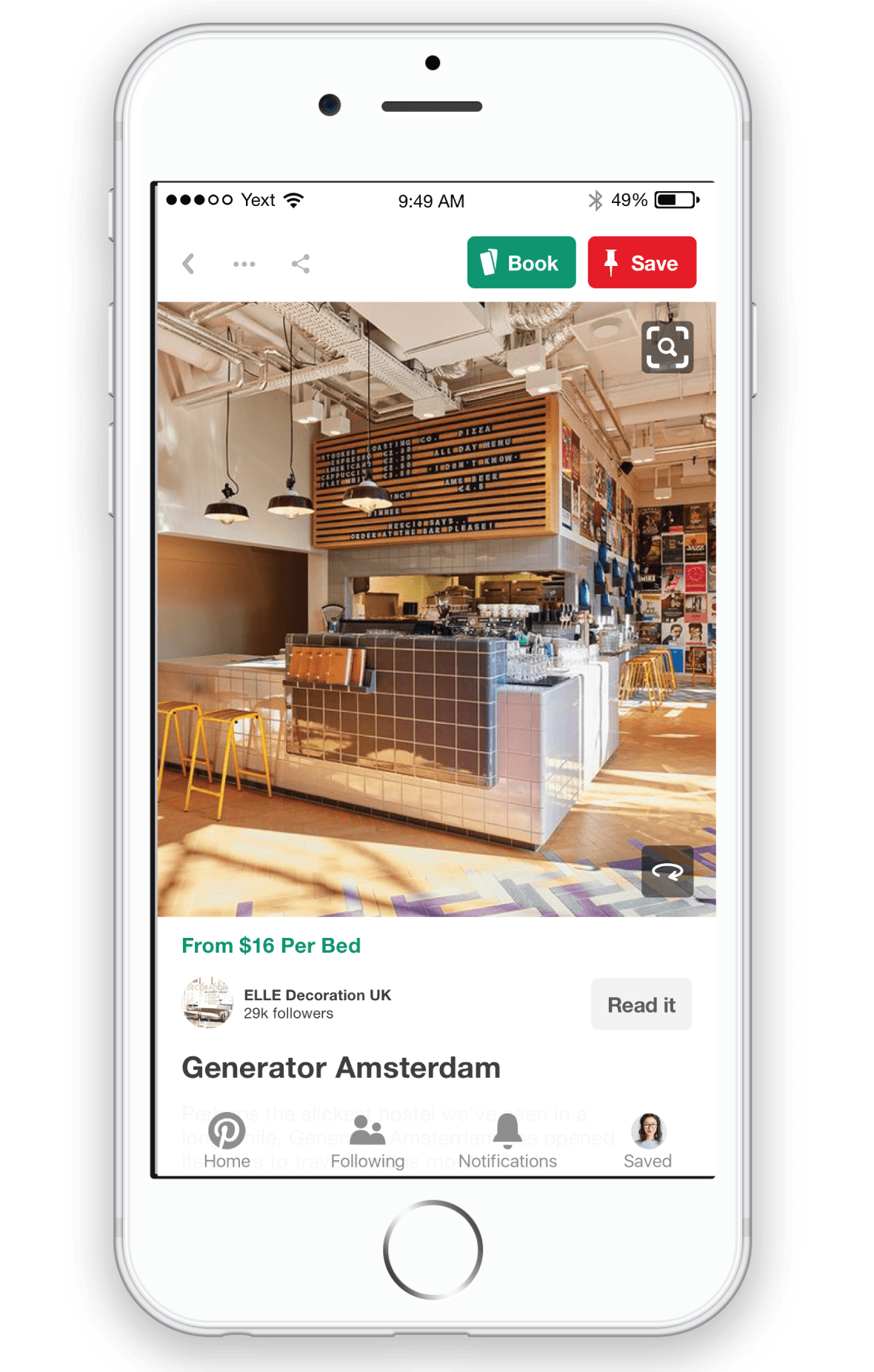
Pinterest Bookable Pins
We compared and evaluated dozen of social platforms and in the end, we selected Pinterest as the final partership based on four major factors: Pinterest's visual content, its discoverability for new brands, the existing travel audience on Pinterest, and lastly, the viability of this partnership for both parties.
We chose Pinterest because of its prominent nature in displaying photography which allows individual brands to position their product and service in a visually appealing way. Consumer then will be able to see Generator’s hostel lifestyle that showcases the following: interior, events, people, food and beverages.
“[Human beings] are visual animals. Sight is the predominant way that we relate to the world around us”
We chose Pinterest because of its discoverability of new brands since “according to a recent survey, 72% of Pinterest users have found a new brand through pinterest.” (Forbes, 2016)
According to Skift, "Pinterest has more than 660 million pins within the travel cateogry alone, and many use Pinterest as a travel planning tool." (Dennis, 2013) This provides Generator a opportunity to connect with the audiences that are seeking to travel.
Since Generator’s unique selling proposition involves a wide range of categories/appeals, the company can also connect to the audiences outside of the travel category such as in food and art. This makes our proposal more unique to Generator, although other brands will also be able to participate as well.
In June 2015, Pinterest introduced Buyable Pins to allow users to purchase items directly from the pinning site. Based on the idea, our team saw an opportunity to simulate similar experience on Pinterest for the hotel/hostel industry.
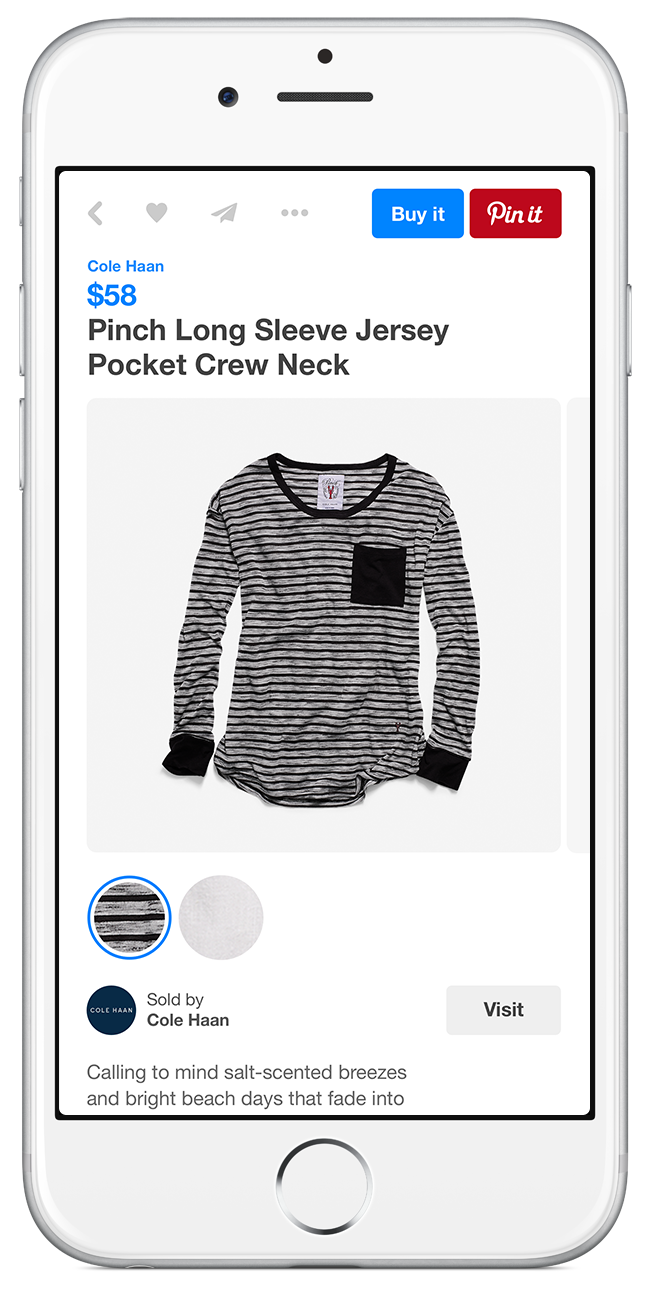
“These features are a big step in helping Pinterest become more of a shopping hub.” - Ben Silberman, founder and CEO of Pinterest
There are countless types of travelers in the world. Therefore, defining our audiences became an essential key in creating our final design.

Through research on different types of traveling experience, it allowed me to utilize cognitive empathy to gain a better understanding of both the materialistic and emotional need of the seekers. What I realized is the fact that although traveling itself is an emotional need, the actual process of traveling can be dissected into many different areas and required a wide range of demands to be fulfilled in order to achieve a memorable traveling experience.
Therefore, by adapting Maslow’s Hierarchy of Needs along with the Brand Experience Pyramid, I developed a model dedicated to our target audience. The experience model summarized all types of needs within the process of traveling into three main levels of traveling experience including enjoyable, immersive, and transformational. In particular, I wanted to focus on designing for a prominent immersive traveling experience for our project; catering to our audiences' need to connect and have social interaction with the local culture.

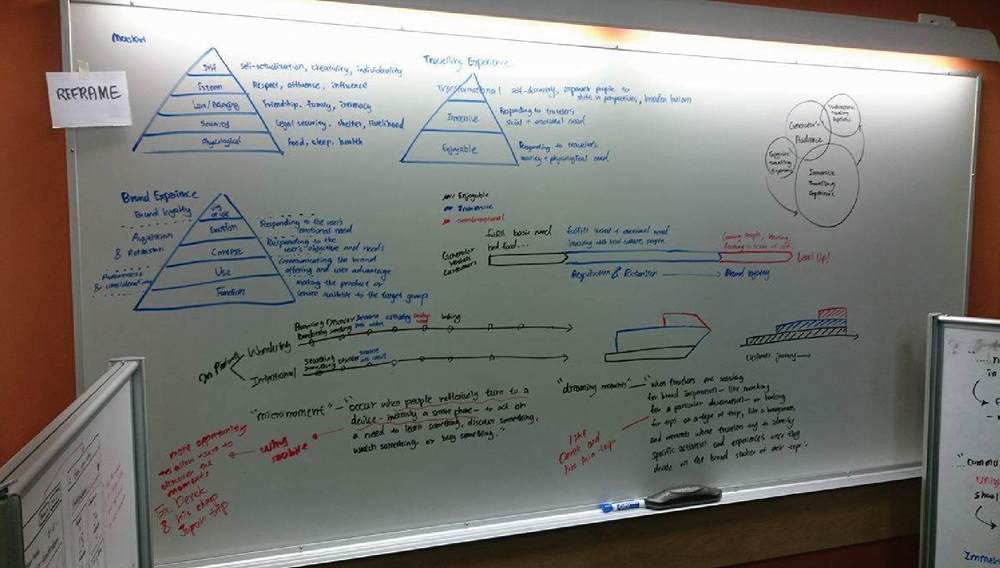
As a team, we’ve decided to transition the three traveling experiences into the browsing experience on Pinterest. In particular, we focus on designing for a high level of immersive traveling experience since that's what the seekers desire after all. They want to be able to connect and have social interaction with the locals. Thus, I collaborated with our team’s visual design lead to come up with our customer journey framework based on the experience model we've made. And this helped us in creating an effective user interface and interaction that would best showcase the visual content provided by Generator in an authentic and immersive fashion.

Following the customer journey, the overall product experience was divided into four segments: Awareness, Consideration, Booking, and Post-booking. These stages each provide feature and elements that not only fulfil our users' need to seek for an immersive travelling experience, but also aligns with Pinterest's app experience.


When users on Pinterest search for any travel related content, they can discover bookable pins that allow them to reserve accomodation associated with a particular hospitality brand. (For example, Generator Hostel!) Users can also use filter to focus on finding their most suitable stay.
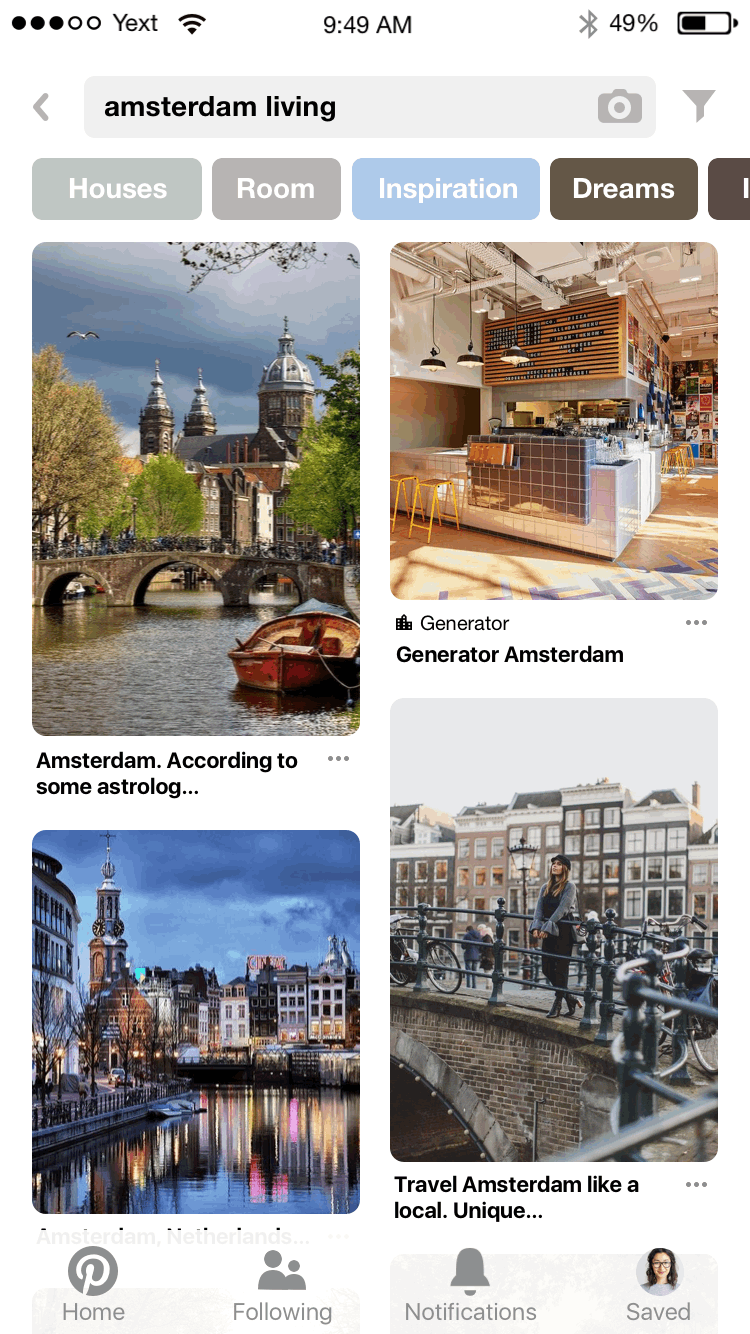
Bookable Pins
Adapting from the "Product Pins", the bookable pins possess their own labelling as well enticing the users to check out accomndations that are related to their search. These labels also help to raise awareness of the individual hospitality brands.

Instead of using the term "Service" which covers a wide of industries and could potentially cause misunderstanding for the user, I'd gone with "Lodging" for upfront and easy-to-understand purposes. That way the users can have a clear perception on what content they are filtering.

Adapting from the Buyable Pins, we believe Bookable Pins should also have their own associated colour. Therefore, we used green as contrary to the Pinterest red for distinction so that user would know these buttons are related for booking accomodation.


Upon clicking on the "Book" call-to-action, user is shown different room options along with the other locations that are associated with the hospitality brand. This helps the customers to find accmondation that best suit their need and also provides references for the users when they plan for any trips in the future.

Locations and room options
After selecting a room, user is presented with photos and information regarding the accomodation such as room perks and room features. By utilizing Pinterest's filtering tags, we also provided travel guide corresponding to the selected destination including art, food and local events. Ultimately, we wanted to appeal and reinforce user's decision by giving thorough details and inspiring ideas.

Room details and places nearby
In addition to places nearby, we also integrated a map so that the users can gain a hollistic understanding of where the hotel/hostel is located. By providing the 360 degree view feature, we aimed to improve customers' ability to access information in the most authentic manner. This also raised their engagement with what the brand has to offer. Within the feature, we'd minimized navigation along with other buttons on screen with hope to emphasize on the visual content and bring a more immersive experience to the users.
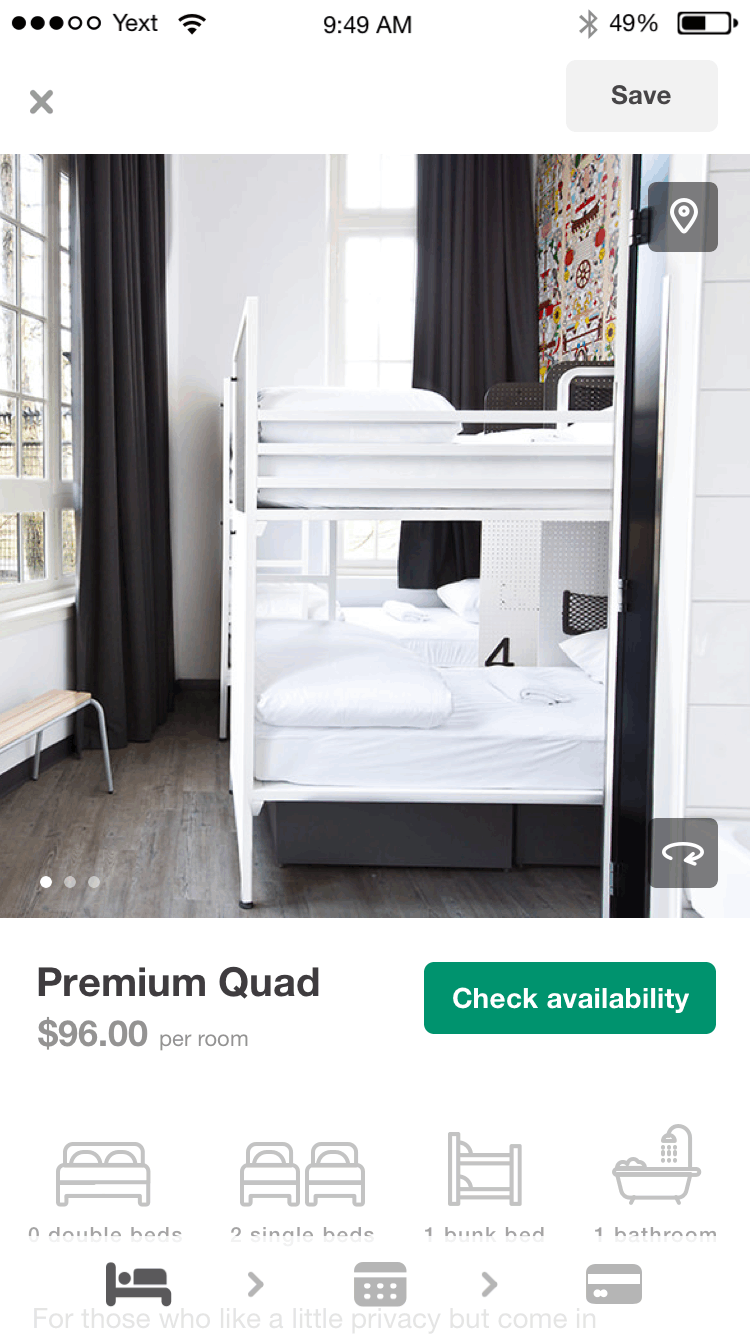
Map and 360 degree view

During the booking stage, we use the calendar style for our UI so that the users can have better sense of time. This helps to reduce cognitive overhead and streamlines the overall reserving process. When checking out, we also had quick payment method such as Apple Pay to keep the whole experience quick and painless.

Dates, guests, and other booking detail

After completing their booking, users can view their trip details from their profile. In addition, we also provided notification and ideas for the users. By bringing what they potentially need or want without them having to ask for it, we continue to raise their engagement with the brand and the platform.
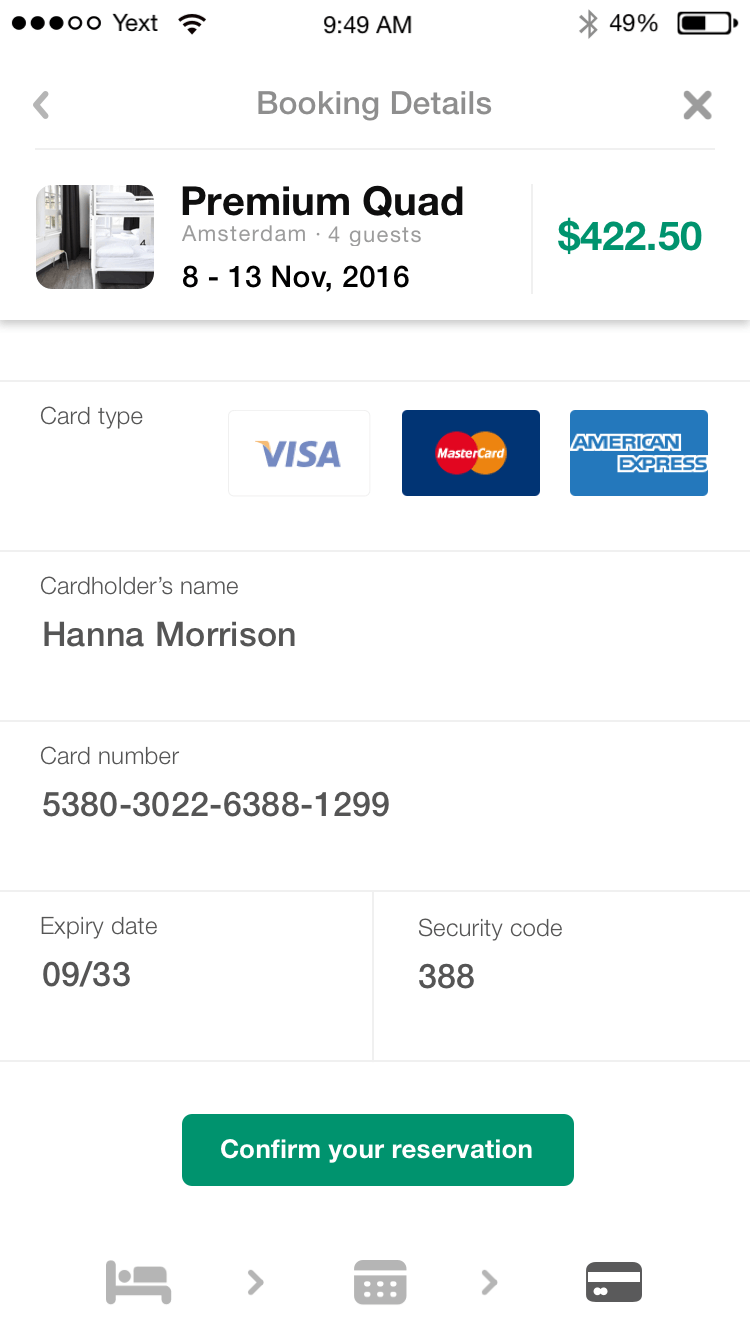
Trip detail and notification
Knowing that booking for a trip is a big commitment, we wanted to make sure the users can easily revisit in case of any sudden changes. Although according to Pinterest, more than 75% of its platform usage takes place on mobile devices, it is important to keep in mind that users will often shift to their desktop to complete their booking. Therefore, I created a "Trips" section within the user's profile across different devices to allow them to review and complete their booking at any time and in any setting.

Our proposed solution aligns with Generator Hostel’s global objective in expanding its property into the North American lodging market. The implementation also helps Pinterest’s in creating a compelling curating experience which fits with the company’s business value. Above all, the feature provides an opportunity to enhance the cultural acceptance of hostels; enabling a new way of traveling experience that is sociable and enjoyable at a lower cost.
Planning a trip should be just as fascinating as the actual traveling experience. It is the ability to be able to visualize and imagine the trip that makes people wanting to travel. Our feature takes this ability further by giving potential travelers a chance to interact and engage with the interior space and local environment of the hostel. That way, people now will be able to discover the accommodation that best suits their interest, and can expect to have an immersive traveling experience that leads to a memorable trip.